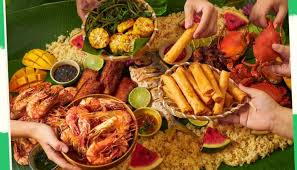The Philippines is more than 7,000 islands — each with its own stories, people, and flavors. This geographical and cultural richness makes the Philippines Restaurants (필리핀 맛집) scene one of the most diverse in Asia.
From the fiery dishes of Bicol to the sweet specialties of Pampanga, every region adds its own identity to the nation’s dining landscape. To truly understand Filipino cuisine, you have to taste it from island to island — one region, one flavor at a time.
Luzon: Hearty Comfort and Classic Favorites
As the country’s largest island, Luzon is home to the nation’s capital, Manila — and a variety of timeless Filipino favorites. The food here is rich, comforting, and deeply traditional.
- Pampanga, often called the “Culinary Capital of the Philippines,” is famous for sisig, a sizzling pork dish that perfectly captures the Filipino love for savory and crispy textures.
- Batangas offers bulalo, a slow-cooked beef shank soup that’s both flavorful and filling — perfect for cool, rainy days.
- In Ilocos, try bagnet (deep-fried pork belly) and empanada, both crunchy and indulgent.
Restaurants across Luzon proudly serve these classics, often preserving old recipes that have been passed down for generations. It’s no wonder the 필리핀 맛집 (Philippines Restaurants) scene here feels like dining inside a Filipino family kitchen.
Visayas: The Heart of Lechon and Island Freshness
In the Visayas, food takes on a lighter, tropical touch — often grilled, roasted, or paired with fresh fruit and seafood.
- Cebu is the undisputed home of lechon, the Philippines’ most iconic dish. The crispy skin and juicy meat of Cebuano lechon are unmatched, drawing food lovers from around the world.
- In Iloilo, don’t miss La Paz Batchoy, a noodle soup with pork, egg, and crushed chicharon (pork crackling).
- Bohol and Negros Occidental highlight farm-to-table freshness — from seafood sinigang to native desserts like piaya and kakanin.
Many Philippines Restaurants (필리핀 맛집) in this region take pride in sourcing ingredients locally — ensuring that each meal reflects the island’s abundance.
Mindanao: Spice, Culture, and Adventure
In Mindanao, the flavors get bolder and more adventurous. Influenced by Malay and Muslim traditions, Mindanaoan cuisine is known for its use of spices, coconut milk, and herbs.
- Davao is famous for kinilaw (Filipino-style ceviche) and tropical fruits like durian and pomelo.
- In Zamboanga, you’ll find dishes like curacha alavar (spanner crab in creamy coconut sauce) and satti (a spicy skewered meat dish).
- The Maranao people of Lanao del Sur offer colorful, turmeric-rich delicacies like piaparan and pastil.
Dining in the southern islands introduces you to a different dimension of 필리핀 맛집 — one that blends heat, depth, and history.
Regional Pride and Local Ingredients
What ties all these regions together is a shared respect for local ingredients. Filipino cuisine celebrates what’s fresh, available, and native — from seafood caught that morning to vegetables grown in backyard gardens.
Many Philippines Restaurants (필리핀 맛집) are now embracing regional menus, showcasing dishes from all over the country to give diners a “tour of the islands” without leaving their seats.
This movement supports local farmers and preserves regional identities while educating diners about the Philippines’ incredible diversity.
read more : Chicken Road Strategies: Safe Exits
The Joy of Discovery
The best part of exploring the 필리핀 맛집 scene is that there’s always something new to try. Whether it’s a hidden carinderia (local eatery) in a small town or a resort restaurant overlooking the sea, each meal brings new flavors and stories.
No two regions taste the same — and that’s exactly what makes dining in the Philippines so special.
Final Thoughts
From the spice of Mindanao to the sweetness of Pampanga, the Philippines is a culinary map waiting to be explored. The country’s regional cuisines aren’t just different recipes — they’re reflections of its landscapes, histories, and people.
So next time you visit, don’t stop at Manila’s famous restaurants. Venture out. Try something from every island. Because the soul of Philippines Restaurants (필리핀 맛집) isn’t found in one place — it’s spread across the entire archipelago.

